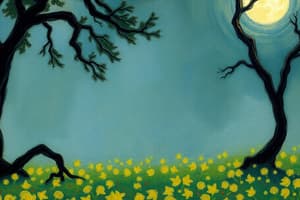Podcast
Questions and Answers
What do learners need to recognize in art class?
What do learners need to recognize in art class?
The difference and uniqueness of art styles of the different art periods.
Which type of rhythm involves similar or identical elements repeating at regular intervals?
Which type of rhythm involves similar or identical elements repeating at regular intervals?
- Alternating Rhythm
- Progressive Rhythm
- Regular Rhythm (correct)
- Random Rhythm
What is the main purpose of unity in a work of art?
What is the main purpose of unity in a work of art?
- To confuse the viewer
- To create a sense of organization or harmony (correct)
- To create a sense of chaos
- To add random elements
Emphasis in a design can be created by using different textures.
Emphasis in a design can be created by using different textures.
What is asymmetrical balance?
What is asymmetrical balance?
Prehistoric artwork means 'before ___.'
Prehistoric artwork means 'before ___.'
When were the earliest examples of surviving artworks created?
When were the earliest examples of surviving artworks created?
What were the earliest artworks primarily made of?
What were the earliest artworks primarily made of?
Paintings found in caves were possibly a way of communication among early humans.
Paintings found in caves were possibly a way of communication among early humans.
Flashcards are hidden until you start studying
Study Notes
Art Class Objectives
- Recognize differences and uniqueness of art styles across art periods.
- Perform and participate competently in creative presentations.
- Create artwork guided by Western Classical Art techniques and styles.
Elements and Principles of Art: Rhythm
- Unifies artwork through repetition of lines, shapes, colors, or other elements.
- Created through regular, random, progressive, or alternating repetition.
Elements and Principles of Art: Unity
- Creates a sense of organization and harmony.
- Achieved through proximity and repetition of elements.
Elements and Principles of Art: Emphasis
- Catches the viewer's eye and directs it to the focal point.
- Created through contrast of shape, color, line, space, and texture.
- Avoid over-emphasis to maintain focal point clarity.
Elements and Principles of Art: Balance
- Visual distribution of weight through color, texture, and space.
- Creates stability.
- Achieved through symmetrical (formal, mirror image) or asymmetrical (informal, contrasting) balance. Weight is influenced by color, value, texture, size, and quantity.
Prehistoric Art
- Encompasses all human art before the invention of writing.
- Provides insights into early human life and culture for historians, archaeologists, and anthropologists.
- Earliest examples are cave drawings dating back to the Paleolithic period (40,000-10,000 BCE). Examples include paintings in El Castillo, Puente Viesgo (Spain) and Chauvet Cave (France).
- Cave paintings may have served as a form of communication.
Art Periods Covered in the Course
- Prehistoric Art
- Mesopotamian Art
- Egyptian Art
- Classical Art
- Medieval Art
Studying That Suits You
Use AI to generate personalized quizzes and flashcards to suit your learning preferences.




